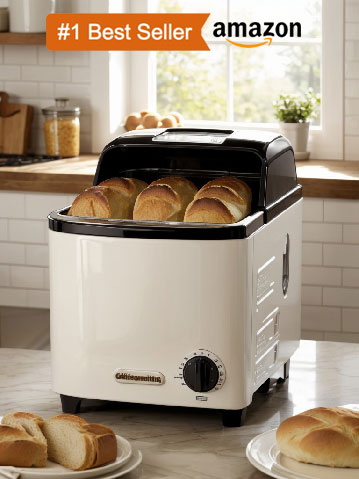Whats The Point Of A Bread Machine
A bread machine is a helpful kitchen appliance that simplifies the process of making fresh, homemade bread. Using a bread machine allows you to create delicious loaves of bread with minimal effort and ingredients. Not only is it an easy way to make homemade bread, but it also provides an opportunity to customize the type of bread you make to suit your family[sq]s needs and tastes.

How to measure ingredients correctly.
Measuring ingredients correctly is an essential part of successful cooking and baking. By measuring ingredients accurately, you will ensure your recipes turn out as intended. It is important to measure ingredients using the right equipment and to use standardized measurements.
For dry ingredients such as flour, sugar, and spices, start by lightly spooning the ingredient into a dry measuring cup or spoon. Level off the ingredient with the back of a knife or a flat edge like the side of a butter knife. If a recipe calls for sifting, sift the ingredient into the measuring cup or spoon before leveling off. For wet ingredients such as milk, oil, and honey, use liquid measuring cups that have lines for specific measurements. Fill the cup to the required line and check the measurement from eye level. If using measuring spoons, make sure they are level and fill them to the top of the spoon. Measuring ingredients properly can be the difference between success and failure in the kitchen. By taking the time to measure accurately, you will ensure that your recipes turn out as intended.
Which type of bread recipe is best suited for the specific bread machine.
The type of bread recipe best suited for a specific bread machine will depend on the model and features of the bread machine. For example, if the bread machine has a timer setting and allows for kneading and rising of the dough, a basic white bread recipe with ingredients such as flour, sugar, salt, yeast, butter or oil, and water is a good choice. If the bread machine features an automatic dough cycle, then recipes that require minimal shaping and baking time will work best.
Other recipes such as quick breads or specialty breads that require additional ingredients such as fruits, nuts, herbs, or spices may also work in some bread machines. It is important to read the manufacturer's instructions and familiarize yourself with your bread machine before attempting to make any recipe. This will ensure that you are using the right settings and have the right ingredients for the type of bread you are trying to make.
See also: Can You Use Milk In Bread Machine
When to add yeast, fruits, nuts, and other ingredients.
Yeast should be added after the wort has cooled to the proper fermentation temperature, usually between 18-24°C (64-75°F). It is important to wait until the temperature is right because adding yeast too soon can lead to off-flavours. Fruits and nuts should also be added after the wort has cooled to the proper temperature.
The specific timing will depend on the type of ingredient being used. For example, adding fresh fruit during primary fermentation will add more flavour and aroma than adding it later in the process. For nuts, it is best to wait until after primary fermentation has finished and the beer has been transferred to a secondary fermenter. This will allow for more time for the nut flavors to be extracted. Other ingredients, such as spices and herbs, can generally be added at any point in the brewing process. However, it is best to add them near the end of fermentation in order to minimize the chances of off-flavors and aromas.
See also: One Pound Loaf Of Raisin Bread In Bread Machine
How to use the various settings on the machine.
The machine has various settings to help you customize your experience and get the most out of it. You can adjust the temperature and the time settings depending on the type of cycle you are using and what results you are looking for. The temperature setting allows you to select the right temperature for your fabrics, so that they are not damaged or over-washed.
You can also adjust the spin speed depending on how delicate the fabrics are, so that they don't get damaged. The timer setting allows you to set a specific time for the washing cycle, which is ideal if you are trying to multitask and don't want the machine to be running too long. Finally, the cycle selection setting allows you to select from pre-set cycles such as gentle, normal, heavy, and super wash, depending on the type of fabric you are washing. All these settings can be adjusted according to your needs and preferences to ensure the best results.
See also: Bread Machine Pumpernickel Bread With Dutch Cocoa
How to properly clean and maintain the machine.
To properly clean and maintain a machine, it is important to follow a regular maintenance schedule. This should include regular inspections and cleaning to ensure that the machine is running properly and safely. Before beginning any maintenance or cleaning process, be sure to read through the manufacturer's instructions for your specific machine.
After turning off the power, start by cleaning the outside of the machine with a damp cloth and mild detergent. Be sure to clean all crevices and remove any dirt or debris. Then, open up the machine, if possible, and use a vacuum cleaner to remove any dust, dirt, or debris. Additionally, inspect the moving parts of the machine and lubricate them as necessary. For electronic components, use a soft brush to remove any dust and debris. If necessary, use a can of compressed air to blow away dust and debris from hard to reach areas. Be sure to use the appropriate cleaning agents when cleaning electronic components, as some detergents may be too harsh and damage them. Finally, after the cleaning and inspection are complete, double check that all screws and bolts are properly tightened. Follow up with a final inspection to ensure that everything is in proper working order before putting the machine back into use. If any problems are found during this inspection, consult with a professional for further assistance. Following these steps will help ensure that your machine is running smoothly and safely for years to come.
See also: Easy Thin Crust Pizza Dough Bread Machine
How to troubleshoot common problems that may arise during baking.
When baking, it is important to troubleshoot any common problems that may arise. The most common problems include under-baked or over-baked goods, uneven browning, and cakey or dry texture. To troubleshoot these problems, start by checking the oven temperature.
Make sure the oven is preheated to the correct temperature and use an oven thermometer to ensure accuracy. If the oven temperature is off, adjust accordingly. If the baking time was incorrect, adjust the baking time for future batches. If the product is not browning evenly, try rotating the pan halfway through baking. Additionally, check to make sure the oven door is closed securely and that it is not letting in too much heat. If the product is still not browning evenly, adjust the oven rack height to ensure even heat distribution. If the product is too cakey or dry, try adjusting the amount of liquids or fats in the recipe and/or adjusting the baking time. Experiment with different temperatures and times until desired results are achieved. Also, make sure to use fresh ingredients as expired ingredients can lead to dryness. By following these tips, common issues can be easily troubleshooted and resolved.
See also: How To Bake Wholemeal Sandwich Bread In Bread Machine
What type of bread pans and loaf sizes are compatible with the machine.
The bread machine is compatible with a variety of bread pans and loaf sizes. It can accommodate two different size pans a 1-pound loaf pan and a 1.5-pound loaf pan. The 1-pound loaf pan is great for making smaller, more single-serving sized loaves of bread, while the 1.5-pound pan is ideal for larger, family-sized loaves.
The machine can also work with baking tins and other baking dishes, allowing you to make many different types of breads and other baked goods. Additionally, the machine can also be used to make specialty items such as cinnamon rolls, which require different types and sizes of pans. The versatility of the machine allows you to make whatever type of bread or baked good you desire.
How long it takes to bake different types of breads.
Baking bread can be a time consuming process and the amount of time it takes to bake different types of breads can vary greatly. For example, a basic white bread can take anywhere from 30 minutes to an hour to bake. On the other hand, artisan and sourdough breads can take much longer depending on the recipe.
Sourdough breads can take anywhere from 8 to 24 hours to complete, as the dough must be allowed to rise slowly over time. Whole wheat breads can also take longer to bake because of the higher percentage of bran and germ in the flour. Baguettes and other French-style breads typically take around 25-30 minutes in the oven and may require additional time for pre-shaping and proofing. Finally, sweet breads such as cinnamon rolls or banana bread can take around an hour to bake.
How to store and freeze the finished product.
To store and freeze the finished product, first cool it completely. Once it is cool, transfer it to a freezer-safe container, such as a resealable plastic bag, an airtight container, or a glass jar. If using a plastic bag, be sure to squeeze out as much air from the bag as possible before sealing it.
Label the container with the product's name and date, and place it in the freezer. To maximize the product's shelf life, freeze it immediately and store it at 0°F or lower. When reheating the product, be sure to thaw it in the refrigerator overnight instead of at room temperature. For best results, use frozen products within two to three months of freezing.
How to adjust recipes for high altitude baking.
Baking at high altitude can be tricky. One of the most important things to keep in mind when adjusting a recipe for high altitude baking is that ingredients such as flour, sugar, butter, and leavening agents (baking powder and baking soda) need to be adjusted.
Flour tends to absorb more moisture at high altitudes than it does at sea level, so using slightly less flour than the recipe calls for can help prevent a dry cake or other baked good. Sugar can also absorb moisture, so reducing the amount of sugar slightly can help to maintain the desired texture of the baked good. Butter should also be reduced slightly at high altitude, as it can cause cakes to become greasy and dense. Leavening agents, such as baking powder and baking soda, should also be used in smaller amounts than the recipe calls for, as they can cause cakes to rise too quickly and then collapse. Additionally, increasing the oven temperature slightly can help to counteract the effects of high altitude baking, as it helps to set the structure of the cake or other baked good quickly. Following these simple tips can help ensure that your high altitude baking experience is a success!





